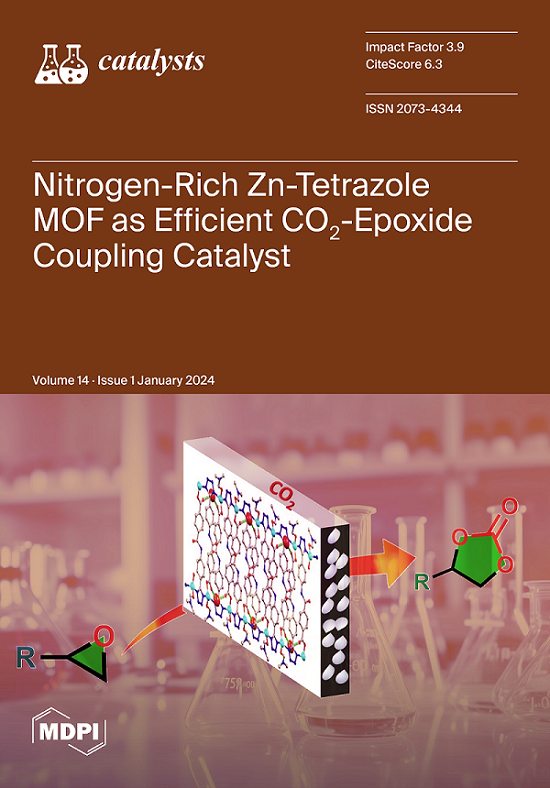Enhancement of Sulfur Oxide Capture Capacity by Deposition of Iron Oxide Particles on Graphene Oxide
IF 4
3区 化学
Q2 CHEMISTRY, PHYSICAL
引用次数: 0
Abstract
Sulfur dioxide (SO2) is a known pollutant that must be captured from gas streams. Dry desulfurization processes are investigated due to their lower energy requirement and potentially high capture efficiency. Carbon materials and metal oxides have been shown to have an affinity with SO2. The aim of this study was to combine iron oxide and graphene oxide (GO) as a composite material for SO2 capture for low-concentration streams. Iron oxide particles were prepared using a polyol method in which the precursor was dispersed in ethylene glycol, heated under reflux and then deposited on GO, a two-dimensional, single-layer material with a surface area of 400 m2/g. The synthesized material was tested for continuous desulfurization in a flow-through capture system with a stream of gas containing 25 ppm SO2 entering at 20 °C and 100 °C. Under all conditions tested, the breakthrough times, evaluated when the SO2 started to be detected at the outlet with a concentration of 1 ppm, as well as the capture capacities, were significantly higher for the iron oxide GO composite than for the pristine GO alone. The presence of sulfur compounds as well as the composite composition were confirmed by energy-dispersive X-ray spectroscopy (EDXS) and X-ray photoelectron spectroscopy (XPS). The breakthrough experiment results at various temperatures also suggest that the capture was not governed only by pure physical adsorption with the presence of iron oxide. Addition of iron oxide particles positively influences SO2 affinity with the synthesized material as shown by the increase in breakthrough time and capture capacity.通过在石墨烯氧化物上沉积氧化铁颗粒提高氧化硫捕获能力
二氧化硫(SO2)是一种已知的污染物,必须从气体流中捕获。由于干法脱硫工艺对能源的要求较低,而且可能具有较高的捕获效率,因此对其进行了研究。碳材料和金属氧化物已被证明与二氧化硫具有亲和性。本研究旨在将氧化铁和氧化石墨烯(GO)作为一种复合材料,用于捕集低浓度气流中的二氧化硫。采用多元醇法制备氧化铁颗粒,将前驱体分散在乙二醇中,在回流条件下加热,然后沉积在 GO(一种表面积为 400 m2/g 的二维单层材料)上。合成的材料在流过式捕集系统中进行了连续脱硫测试,在 20 °C 和 100 °C 的温度下进入的气流中含有 25 ppm 的二氧化硫。在所有测试条件下,氧化铁 GO 复合材料的突破时间(在出口处开始检测到浓度为百万分之 1 的二氧化硫时进行评估)和捕集能力都明显高于单独的原始 GO。能量色散 X 射线光谱(EDXS)和 X 射线光电子能谱(XPS)证实了硫化合物的存在以及复合材料的成分。在不同温度下进行的突破实验结果也表明,在氧化铁存在的情况下,捕获并不仅仅受纯物理吸附的影响。氧化铁颗粒的加入对二氧化硫与合成材料的亲和性产生了积极影响,这体现在突破时间和捕获能力的增加上。
本文章由计算机程序翻译,如有差异,请以英文原文为准。
求助全文
约1分钟内获得全文
求助全文
来源期刊

Catalysts
CHEMISTRY, PHYSICAL-
CiteScore
6.80
自引率
7.70%
发文量
1330
审稿时长
3 months
期刊介绍:
Catalysts (ISSN 2073-4344) is an international open access journal of catalysts and catalyzed reactions. Catalysts publishes reviews, regular research papers (articles) and short communications. Our aim is to encourage scientists to publish their experimental and theoretical results in as much detail as possible. Therefore, there is no restriction on the length of the papers. The full experimental details must be provided so that the results can be reproduced.
 求助内容:
求助内容: 应助结果提醒方式:
应助结果提醒方式:


